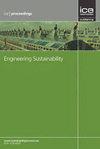不同阳离子的碱活化剂将低价值火山灰转化为环保地聚合物
IF 1.5
4区 工程技术
Q3 ENGINEERING, CIVIL
Proceedings of the Institution of Civil Engineers-Engineering Sustainability
Pub Date : 2023-01-19
DOI:10.1680/jensu.22.00078
引用次数: 0
摘要
地聚合物是一种绿色和可持续的胶凝材料,由于其低能耗和低排放,可能成为水泥的替代品。火山灰被认为是一种低价值的材料,因为它分布在世界各地,储量巨大,但应用有限。火山灰具有较高的二氧化硅和氧化铝含量,可作为碱活化法制备地聚合物的原料。然而,对火山灰基地聚合物的研究仍然有限,对最佳的碱活化剂没有达成共识,反应机理也不清楚。研究了不同阳离子碱性活化剂对火山灰基地聚合物力学性能和微观结构的影响。对其抗折和抗压强度进行了评价。采用x射线衍射、傅里叶变换红外光谱、扫描电镜-能量色散光谱和29Si魔角自旋-核磁共振对其微观结构进行了表征。结果表明:NaOH对火山灰的碱活化效果优于LiOH和KOH,特别是在浓度为8 mol/L时,其28 d抗弯强度和抗压强度分别为3.0 MPa和28.3 MPa;微观结构结果表明,LiOH和KOH可以诱导火山灰发生地聚合,生成松散颗粒作为产物。相反,naoh活化的地聚合物形成致密、连续、高聚合的硅铝酸盐凝胶。本文为本研究中开采的火山灰活化提供了合适的配比方案,促进了实际应用,有利于未来工程的可持续发展。本文章由计算机程序翻译,如有差异,请以英文原文为准。
Alkali activators with different cations transforming low-value volcanic ash into eco-friendly geopolymers
Geopolymers are green and sustainable cementitious materials as a possible alternative to cement due to lower energy consumption and emissions. Volcanic ash is considered a low-value material because of its worldwide distribution and huge reserves but limited applications. Beneficial to its high silica and alumina content, volcanic ash can be used as raw material to prepare geopolymers by alkali activation. However, research on volcanic ash-based geopolymers is still limited, no consensus on the optimal alkali activator is obtained, and the reaction mechanism is not yet clear. This paper aims to investigate the effect of alkali activators with different cations on the mechanical properties and microstructure of volcanic ash-based geopolymers. The flexural and compressive strength were evaluated. X-ray diffractometry, Fourier Transform Infrared Spectrometry, Scanning Electron Microscopy coupled with Energy Dispersive Spectroscopy, and 29Si Magic Angle Spinning-Nuclear Magnetic Resonance were used to characterize the microstructural properties. The results showed that the alkali activation effect of NaOH on volcanic ash was superior to that of LiOH and KOH, especially at a concentration of 8 mol/L, with 28-d flexural and compressive flexural strengths of 3.0 MPa and 28.3 MPa, respectively. Microstructural results indicated that LiOH and KOH could induce volcanic ash to undergo geopolymerization to generate loose particles as products. In contrast, the NaOH-activated geopolymers formed dense, continuous, highly polymerized silica-aluminate gels. This paper provides a proper ratio scheme for activating the volcanic ash mined from the deposit in the present study and promoting practical applications conducive to sustainable engineering development in the future.
求助全文
通过发布文献求助,成功后即可免费获取论文全文。
去求助
来源期刊

Proceedings of the Institution of Civil Engineers-Engineering Sustainability
ENGINEERING, CIVIL-ENGINEERING, CIVIL
CiteScore
3.70
自引率
16.70%
发文量
44
审稿时长
>12 weeks
期刊介绍:
Engineering Sustainability provides a forum for sharing the latest thinking from research and practice, and increasingly is presenting the ''how to'' of engineering a resilient future. The journal features refereed papers and shorter articles relating to the pursuit and implementation of sustainability principles through engineering planning, design and application. The tensions between and integration of social, economic and environmental considerations within such schemes are of particular relevance. Methodologies for assessing sustainability, policy issues, education and corporate responsibility will also be included. The aims will be met primarily by providing papers and briefing notes (including case histories and best practice guidance) of use to decision-makers, practitioners, researchers and students.
 求助内容:
求助内容: 应助结果提醒方式:
应助结果提醒方式:


